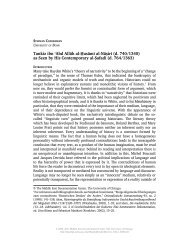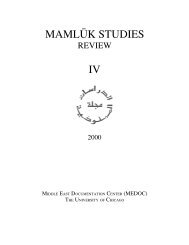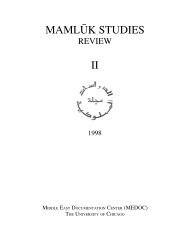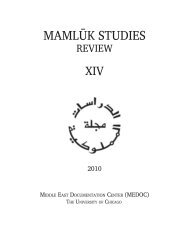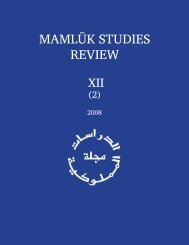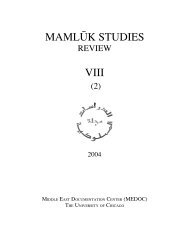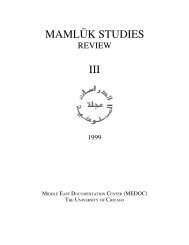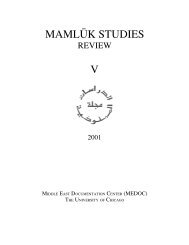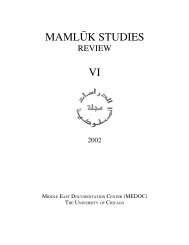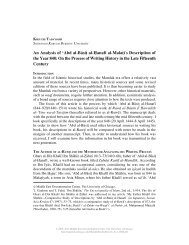The Archaeological Evidence from the Mamluk Siege of Arsuf (MSR ...
The Archaeological Evidence from the Mamluk Siege of Arsuf (MSR ...
The Archaeological Evidence from the Mamluk Siege of Arsuf (MSR ...
Create successful ePaper yourself
Turn your PDF publications into a flip-book with our unique Google optimized e-Paper software.
KATE RAPHAEL<br />
THE HEBREW UNIVERSITY OF JERUSALEM<br />
YOTAM TEPPER<br />
TEL AVIV UNIVERSITY<br />
<strong>The</strong> <strong>Archaeological</strong> <strong>Evidence</strong> <strong>from</strong> <strong>the</strong> <strong>Mamluk</strong> <strong>Siege</strong> <strong>of</strong> Arsu≠f<br />
During <strong>the</strong> past five seasons <strong>of</strong> excavations at <strong>the</strong> Crusader fortress <strong>of</strong> Arsu≠f, over<br />
a thousand arrowheads were found along with close to three thousand catapult<br />
stones. It is important to note that those numbers will change once <strong>the</strong> excavation<br />
<strong>of</strong> <strong>the</strong> moat is completed. <strong>The</strong> aim <strong>of</strong> this article is to map <strong>the</strong> distribution <strong>of</strong> <strong>the</strong><br />
arrowheads and catapult stones, and try to determine <strong>the</strong> location <strong>of</strong> <strong>the</strong> <strong>Mamluk</strong><br />
siege machines and archers that were employed throughout <strong>the</strong> battle. We shall<br />
also discuss some <strong>of</strong> <strong>the</strong> problems that Baybars encountered and solved while<br />
preparing his siege engines.<br />
Each arrowhead and catapult stone was marked on <strong>the</strong> map <strong>of</strong> <strong>the</strong> site according<br />
to where it was found. Due to rain and landslides <strong>the</strong> original location may have<br />
shifted somewhat, so <strong>the</strong> locations given here are approximate.<br />
As we were mapping out <strong>the</strong> location <strong>of</strong> each arrowhead and catapult stone on<br />
<strong>the</strong> map <strong>of</strong> <strong>the</strong> fortress <strong>of</strong> Arsu≠f, <strong>the</strong> full scale <strong>of</strong> <strong>the</strong> final stage <strong>of</strong> <strong>the</strong> <strong>Mamluk</strong><br />
siege slowly became clear. One can easily imagine <strong>the</strong> force <strong>of</strong> <strong>the</strong> attack, <strong>the</strong><br />
heavy bombardment and <strong>the</strong> horrifying sound <strong>of</strong> maja≠n|q stones continually<br />
thundering and crashing down on <strong>the</strong> citadel during <strong>the</strong> final three days after <strong>the</strong><br />
city itself had been taken; <strong>the</strong>re would have been scarcely a place within <strong>the</strong> walls<br />
<strong>of</strong> <strong>the</strong> citadel that was safe or protected.<br />
1243 ARROWHEADS AND 2748 CATAPULT STONES<br />
<strong>The</strong> arrowheads are all <strong>of</strong> <strong>the</strong> same design. Made <strong>of</strong> iron, <strong>the</strong>ir average length was<br />
4.5 cm and <strong>the</strong>ir width approximately 1 cm. In cross section <strong>the</strong>y are square or<br />
diamond shaped. <strong>The</strong> shaft was secured to <strong>the</strong> arrowhead with a tang that was<br />
driven deep into <strong>the</strong> wood (Fig. 1). Similar arrowheads were found on various<br />
Crusader and <strong>Mamluk</strong> sites: Montfort (al-Qurayn), Chastel Pèlerin (‘Athl|th),<br />
Yoqne’am, Safed, Burj al-Ah˝mar, H˛ama≠h, Vadum Jacob (Bayt al-Mah˝a≠zin), and<br />
Belvoir (Kawkab al-Hawa≠’). 1 This design seems to have been dominant throughout<br />
© Middle East Documentation Center. <strong>The</strong> University <strong>of</strong> Chicago.<br />
1<br />
D. Bashford, "A Crusader Fortress in Palestine," <strong>The</strong> Bulletin <strong>of</strong> <strong>the</strong> Metropolitan Museum <strong>of</strong><br />
Art, Sept. 1927, pt. 2, Fig. 53:N; C. N. Johns, "Excavations at Pilgrims Castle ‘Atlit (1932–3):<br />
© 2005, 2012 Middle East Documentation Center, <strong>The</strong> University <strong>of</strong> Chicago.<br />
http://mamluk.uchicago.edu/<strong>Mamluk</strong>StudiesReview_IX-1_2005.pdf
86 KATE RAPHAEL AND YOTAM TEPPER, THE ARCHAEOLOGICAL EVIDENCE FROM ARSU≠F<br />
<strong>the</strong> twelfth and thirteenth centuries. From <strong>the</strong> evidence ga<strong>the</strong>red so far, <strong>the</strong>y were<br />
used by both Frankish and Muslim archers. 2 <strong>The</strong>y were designed to penetrate<br />
armor, and once imbedded in <strong>the</strong> flesh, pulling <strong>the</strong>m out became a tricky maneuver,<br />
since <strong>the</strong> shaft was more than likely to break, leaving <strong>the</strong> arrowhead buried deep<br />
inside <strong>the</strong> flesh. <strong>The</strong> shafts were made out <strong>of</strong> pine or cedar. 3 Only five arrowheads<br />
differ <strong>from</strong> those described above. Those five are kite shaped and flat (Fig. 2).<br />
<strong>The</strong>y were <strong>of</strong>ten used for hunting game or for wounding horses in times <strong>of</strong> battle. 4<br />
Although <strong>the</strong> <strong>Mamluk</strong> archers played an important part in <strong>the</strong> siege, <strong>the</strong> main role<br />
belonged to <strong>the</strong> teams that operated <strong>the</strong> siege machines, and <strong>the</strong> engineers who<br />
assembled <strong>the</strong>m. <strong>The</strong> masons who quarried <strong>the</strong> stone saw that <strong>the</strong> weights matched<br />
<strong>the</strong> required order and shaped <strong>the</strong> stones into suitable projectiles.<br />
Arsu≠f has so far been <strong>the</strong> only site within <strong>the</strong> boundaries <strong>of</strong> <strong>the</strong> Crusader<br />
kingdom that has yielded such a large number <strong>of</strong> trebuchet stones. Although many<br />
sieges were recorded by both Latin and Muslim sources, very few sites have<br />
supplied <strong>the</strong> archaeological evidence to support <strong>the</strong> historical sources. While some<br />
sites have not yet been excavated, o<strong>the</strong>rs have simply been resettled and <strong>the</strong><br />
archaeological evidence lost or scattered. Much has been written on siege warfare<br />
in <strong>the</strong> Latin East, <strong>the</strong> invention and development <strong>of</strong> siege engines, and <strong>the</strong> changes<br />
that followed in <strong>the</strong> field <strong>of</strong> military architecture. Most <strong>of</strong> those works rely on <strong>the</strong><br />
examination <strong>of</strong> historical sources, some on experimental archaeology, but very<br />
few have ga<strong>the</strong>red evidence <strong>from</strong> <strong>the</strong> actual fortresses, towns, or cities where<br />
those sieges occurred. 5 <strong>The</strong> importance <strong>of</strong> Arsu≠f lies in <strong>the</strong> fact that in addition to<br />
Stables at South West Suburb," Quarterly <strong>of</strong> <strong>the</strong> Department <strong>of</strong> Antiquities <strong>of</strong> Palestine 5 (1936),<br />
fig. 15:2; A. Khamis, "Chapter 18: <strong>The</strong> Metal Objects," in Yoqne’am: <strong>The</strong> Later Periods (=Qedem<br />
Reports 3), ed. A. Ben Tor, M. Avisar, and Y. Portugali (Jerusalem, 1996), photo. xviii.4, No. 6;<br />
E. Damati, "Safed Citadel," in Excavations and Survey in Israel 1988–89, 7–8 (Jerusalem<br />
1988–89),159–60; D. Pringle, <strong>The</strong> Red Tower (al-Burj al-Ahmar): Settlement in <strong>the</strong> Plain <strong>of</strong><br />
Sharon at <strong>the</strong> Time <strong>of</strong> <strong>the</strong> Crusaders and <strong>Mamluk</strong>s A.D. 1099–1516 (London 1986), fig. 57:21, 22;<br />
G. Ploug et al., Hama, 1932–1938 IV3 (Copenhagen, 1969), fig. 21:1; K. Raphael, "Archers in <strong>the</strong><br />
Crusader Period," M.A <strong>the</strong>sis, Hebrew University, 2001; M. Ben Dov, "Crusader Fortresses in<br />
Eretz Israel," in Qadmoniot 32 (=vol. 8, no. 4) (1975), 102–14 (in Hebrew).<br />
2 Raphael, "Archers in <strong>the</strong> Crusader Period," 103–16.<br />
3 <strong>The</strong> botanical research was done by Dr. Nili Lifshitz <strong>from</strong> Tel Aviv University. Among <strong>the</strong><br />
shafts that were examined <strong>the</strong>re was also a type <strong>of</strong> coniferous wood that could not be identified<br />
with certainty.<br />
4 W. Swietoslawski, Arms and Armour <strong>of</strong> <strong>the</strong> Nomads <strong>of</strong> <strong>the</strong> Great Steppe in <strong>the</strong> Times <strong>of</strong> <strong>the</strong><br />
Mongol Expansion, trans. M. Abramowicz (Lodz, 1999), 131, plate XIX:4–6.<br />
5 Christopher Marshall, Warfare in <strong>the</strong> Latin East, 1191–1291 (Cambridge, 1996), 212–14; J.<br />
Bradbury, <strong>The</strong> Medieval <strong>Siege</strong> (Suffolk, 1992); P. Chevedden, "Artillery in Late Antiquity," in <strong>The</strong><br />
Medieval City under <strong>Siege</strong>, ed. I. A. Corfis and M. Wolf (Woodbridge, 1995), 131–73; P. Chevedden,<br />
"Fortifications and <strong>the</strong> Development <strong>of</strong> Defensive Planning during <strong>the</strong> Crusader Period," in <strong>The</strong><br />
© 2005, 2012 Middle East Documentation Center, <strong>The</strong> University <strong>of</strong> Chicago.<br />
http://mamluk.uchicago.edu/<strong>Mamluk</strong>StudiesReview_IX-1_2005.pdf
MAMLU±K STUDIES STUDIES REVIEW REVIEW VOL. VOL. 9, NO. 8/1, 1, 2004 2005 87<br />
<strong>the</strong> historical references, we can map and analyze <strong>the</strong> catapult stones and arrowheads<br />
that have been left as testimony to <strong>the</strong> <strong>Mamluk</strong> siege that took place in <strong>the</strong> spring<br />
<strong>of</strong> 1265.<br />
Out <strong>of</strong> <strong>the</strong> 2747 catapult stones that were found, 800 were measured and<br />
weighed (Chart 1). While working on <strong>the</strong> typology, we noticed that <strong>the</strong> catapult<br />
stones that were found to <strong>the</strong> north <strong>of</strong> <strong>the</strong> gate, among a pile <strong>of</strong> burnt cedar logs,<br />
were larger in diameter and heavier than <strong>the</strong> stones that were collected <strong>from</strong> <strong>the</strong><br />
main area within <strong>the</strong> citadel walls (Map 1). It is more than likely that <strong>the</strong> siege<br />
engine, which dealt with <strong>the</strong> Frankish defenders who evidently took refuge under<br />
<strong>the</strong> wooden construction, was <strong>of</strong> a different type and was capable <strong>of</strong> hurling<br />
stones <strong>of</strong> greater diameter and weight. <strong>The</strong> prevalent weights <strong>of</strong> <strong>the</strong> catapult<br />
stones that were found in <strong>the</strong> area <strong>of</strong> <strong>the</strong> burnt cedar logs were 16 kg, 20 kg, 28<br />
kg, and 35 kg (Chart 2).<br />
Although <strong>the</strong> majority <strong>of</strong> catapult stones are carved out <strong>of</strong> limestone, <strong>the</strong>y<br />
vary a great deal in weight, diameter, shape, and quality <strong>of</strong> <strong>the</strong> stone dressing. <strong>The</strong><br />
table below gives <strong>the</strong> dominant weights and diameters among <strong>the</strong> catapult stones<br />
that were found within <strong>the</strong> fortress walls.<br />
WEIGHTS AND DIAMETERS OF THE CATAPULT STONES IN ARSU≠F<br />
Weight (kg) Diameter (cm)<br />
8 20<br />
10–11 21–23<br />
16 25<br />
20 27–28<br />
28 30<br />
35 31<br />
40 33–34<br />
41–42 35–37<br />
48 40<br />
<strong>The</strong> heaviest catapult stone reached 78 kg, but altoge<strong>the</strong>r only 11 catapult stones<br />
weighed over 70 kg. <strong>The</strong> lowest weights recorded are 1–3 kg. Almost 50 stones<br />
weighed less than 3 kg. 6 While <strong>the</strong> majority are carved, some are more like huge<br />
pebbles (Fig. 3), and appear to have been ga<strong>the</strong>red <strong>from</strong> <strong>the</strong> mouth <strong>of</strong> a riverbed at<br />
Circle <strong>of</strong> War in <strong>the</strong> Middle Ages: Essays on Medieval Military and Naval History, ed. D. J.<br />
Kagay and A. J. A. Villalon (Suffolk, 1999), 33–43; K. DeVries, Medieval Military Technology<br />
(Peterborough, Canada, 1998), 133–40; Swietoslawski, Arms and Armour, 70–71.<br />
6<br />
Some <strong>of</strong> those stones may have broken and <strong>the</strong>refore <strong>the</strong>se figures may not represent <strong>the</strong><br />
original weight.<br />
© 2005, 2012 Middle East Documentation Center, <strong>The</strong> University <strong>of</strong> Chicago.<br />
http://mamluk.uchicago.edu/<strong>Mamluk</strong>StudiesReview_IX-1_2005.pdf
88 KATE RAPHAEL AND YOTAM TEPPER, THE ARCHAEOLOGICAL EVIDENCE FROM ARSU≠F<br />
<strong>the</strong> foot <strong>of</strong> <strong>the</strong> Samarian hills to <strong>the</strong> east <strong>of</strong> Arsu≠f. 7 Among <strong>the</strong> catapult stones that<br />
are dressed, a small percentage has an almost perfect round shape (Fig. 4); most<br />
are roughly round and dressed in a coarse manner. Very few are just large stones<br />
that have not been dressed and simply left with jagged rough edges (Fig. 5). Five<br />
catapult stones were carved out <strong>of</strong> a marble Roman-Byzantine column (Fig. 6).<br />
Two are <strong>from</strong> flint, and four <strong>from</strong> kurkar (calcareous sandstone, found along <strong>the</strong><br />
coast <strong>of</strong> Israel), which would have left very little impact on <strong>the</strong> fortress walls.<br />
One <strong>of</strong> <strong>the</strong> problems Baybars encountered while laying out <strong>the</strong> plan and setting<br />
up <strong>the</strong> logistics for <strong>the</strong> siege <strong>of</strong> Arsu≠f would have been finding a nearby quarry<br />
that could supply <strong>the</strong> stone for <strong>the</strong> making <strong>of</strong> stone projectiles. <strong>The</strong> cliffs overlooking<br />
<strong>the</strong> sea are made <strong>of</strong> kurkar, which was used for <strong>the</strong> construction <strong>of</strong> <strong>the</strong> fortress,<br />
but is not quite suitable for <strong>the</strong> making <strong>of</strong> catapult stones. Prior to <strong>the</strong> beginning<br />
<strong>of</strong> <strong>the</strong> siege and possibly while <strong>the</strong> fighting was taking place, a group <strong>of</strong> masons<br />
were busy preparing catapult stones at nearby quarries. <strong>The</strong> stones were probably<br />
<strong>the</strong>n loaded on large wagons that were sent <strong>of</strong>f to <strong>the</strong> <strong>Mamluk</strong> siege camp. As<br />
noted above, <strong>the</strong> source <strong>of</strong> <strong>the</strong> limestone has been identified at <strong>the</strong> foot <strong>of</strong> <strong>the</strong><br />
nearby Samarian hills which lay approximately 15 km to <strong>the</strong> east <strong>of</strong> Arsu≠f.<br />
In order to try to calculate <strong>the</strong> location <strong>of</strong> <strong>the</strong> <strong>Mamluk</strong> archers and siege<br />
machines, each arrowhead and catapult stone was marked on <strong>the</strong> map <strong>of</strong> <strong>the</strong><br />
fortress. Both maps show a similar distribution. <strong>The</strong> majority <strong>of</strong> <strong>the</strong> arrowheads,<br />
812 (65%), were found between <strong>the</strong> two towers <strong>of</strong> <strong>the</strong> main gate (Map 1). This<br />
correlates with 1112 (40%) catapult stones that were ga<strong>the</strong>red <strong>from</strong> around and<br />
between <strong>the</strong> walls <strong>of</strong> <strong>the</strong> gate (Map 2). <strong>The</strong> majority <strong>of</strong> <strong>the</strong> catapult stones in <strong>the</strong><br />
region <strong>of</strong> <strong>the</strong> main gate fell somewhat closer to <strong>the</strong> nor<strong>the</strong>astern gate tower. This<br />
may indicate that a siege machine was stationed almost opposite, at an angle <strong>of</strong><br />
fire that gave a clear view and turned <strong>the</strong> nor<strong>the</strong>rn gate tower into a relatively easy<br />
target. On <strong>the</strong> o<strong>the</strong>r hand, <strong>the</strong> sou<strong>the</strong>rn gate tower yielded less than 75 catapult<br />
stones. <strong>The</strong> front wall <strong>of</strong> <strong>the</strong> sou<strong>the</strong>rn tower is slightly damaged on <strong>the</strong> side facing<br />
<strong>the</strong> nor<strong>the</strong>ast (Fig. 7), giving a clear idea <strong>of</strong> <strong>the</strong> angle <strong>of</strong> fire. As noted above, one<br />
<strong>of</strong> <strong>the</strong> larger or stronger siege engines was positioned directly in front <strong>of</strong> <strong>the</strong><br />
wooden construction. <strong>The</strong> markings left on <strong>the</strong> sou<strong>the</strong>astern peripheral wall (Fig.<br />
7) indicate that at least one <strong>of</strong> <strong>the</strong> siege engines must have been carried through<br />
<strong>the</strong> town after it fell and stationed on <strong>the</strong> sou<strong>the</strong>ast edge <strong>of</strong> <strong>the</strong> fortress moat.<br />
7 According to <strong>the</strong> geological survey conducted by Ram Ben-David.<br />
© 2005, 2012 Middle East Documentation Center, <strong>The</strong> University <strong>of</strong> Chicago.<br />
http://mamluk.uchicago.edu/<strong>Mamluk</strong>StudiesReview_IX-1_2005.pdf
MAMLU±K STUDIES STUDIES REVIEW REVIEW VOL. VOL. 9, NO. 8/1, 1, 2004 2005 89<br />
In an analysis <strong>of</strong> <strong>the</strong> siege given by Meron Benvenisti it is proposed that<br />
Baybars opened his attack <strong>from</strong> <strong>the</strong> south. 8 This view seems quite unlikely, as <strong>the</strong><br />
distribution <strong>of</strong> catapult stones is mainly in <strong>the</strong> nor<strong>the</strong>rn section <strong>of</strong> <strong>the</strong> fortress. 9<br />
<strong>The</strong> land to <strong>the</strong> north and <strong>the</strong> nor<strong>the</strong>ast <strong>of</strong> <strong>the</strong> fortress is slightly elevated, so<br />
that <strong>the</strong> <strong>Mamluk</strong> siege engines may have gained sufficient advantage, until <strong>the</strong><br />
city wall was breached. It seems, though, that <strong>the</strong> <strong>Mamluk</strong> force concentrated<br />
most <strong>of</strong> its efforts opposite <strong>the</strong> main gate. From <strong>the</strong> archaeological evidence it<br />
appears that a fierce attack was carried out by both siege engines and a strong<br />
group <strong>of</strong> archers that was stationed almost opposite <strong>the</strong> gate. <strong>The</strong> following<br />
description may indicate that a great crossbow was used in <strong>the</strong> attempt to break<br />
through <strong>the</strong> main gate.<br />
Among <strong>the</strong> arrowheads that were found between <strong>the</strong> gate towers was a huge<br />
bolt made <strong>of</strong> iron (Fig. 8a–b). 10 While cleaning <strong>the</strong> bolt under a magnifying glass<br />
strands <strong>of</strong> rope could be seen. <strong>The</strong> rope had been tightly tied around <strong>the</strong> bolt and<br />
one <strong>of</strong> <strong>the</strong> knots is still quite visible. 11 <strong>The</strong> size and weight <strong>of</strong> <strong>the</strong> bolt present <strong>the</strong><br />
possibility that it was shot out <strong>of</strong> a large crossbow that was probably mounted on<br />
a wooden frame. As <strong>the</strong> bolt is covered with burnt fragments <strong>of</strong> wood it is<br />
possible that it served as a torch and <strong>the</strong> rope secured a thick piece <strong>of</strong> cloth that<br />
was lit and aimed at <strong>the</strong> wooden doors that secured <strong>the</strong> main entrance to <strong>the</strong><br />
fortress.<br />
<strong>The</strong> southwest corner <strong>of</strong> <strong>the</strong> fortress yielded 187 arrowheads. <strong>The</strong>re are a<br />
number <strong>of</strong> explanations that may be given in order to understand this scattered<br />
distribution. It could indicate that those arrows were shot once <strong>the</strong> fortress was<br />
entered and close combat took place within <strong>the</strong> fortress walls. Or, <strong>the</strong>y may have<br />
been shot by a group <strong>of</strong> archers that made its way through <strong>the</strong> city and stood south<br />
<strong>of</strong> <strong>the</strong> fortress moat.<br />
When it comes to establishing <strong>the</strong> type <strong>of</strong> siege engines that Baybars used, <strong>the</strong><br />
task becomes ra<strong>the</strong>r difficult. Although <strong>the</strong> weight <strong>of</strong> <strong>the</strong> catapult stones varies a<br />
great deal, most stones could be lifted by one man, while <strong>the</strong> heavier stones<br />
required two people, who could handle each stone without much strain. This does<br />
not fit <strong>the</strong> descriptions <strong>of</strong> weights given by some <strong>of</strong> <strong>the</strong> Latin and Muslim chronicles<br />
and <strong>the</strong> modern historians that have dealt with <strong>the</strong> subject <strong>of</strong> early medieval siege<br />
warfare.<br />
8<br />
M. Benvenisti, <strong>The</strong> Crusaders in <strong>the</strong> Holy Land (Jerusalem, 1976), 133. It is not clear if this<br />
refers to <strong>the</strong> attack on <strong>the</strong> town or <strong>the</strong> fortress.<br />
9<br />
For <strong>the</strong> development <strong>of</strong> <strong>the</strong> siege, see <strong>the</strong> article by R. Amitai in this volume.<br />
10<br />
With it were two fragments that seem to belong to bolts <strong>of</strong> a similar size and design.<br />
11<br />
We would like to thank Mimi Lavi, who heads <strong>the</strong> conservation laboratory in <strong>the</strong> Institute <strong>of</strong><br />
Archaeology <strong>of</strong> <strong>the</strong> Hebrew University, for pointing out this incredible find to us.<br />
© 2005, 2012 Middle East Documentation Center, <strong>The</strong> University <strong>of</strong> Chicago.<br />
http://mamluk.uchicago.edu/<strong>Mamluk</strong>StudiesReview_IX-1_2005.pdf
90 KATE RAPHAEL AND YOTAM TEPPER, THE ARCHAEOLOGICAL EVIDENCE FROM ARSU≠F<br />
Paul Chevedden states that <strong>the</strong> hybrid trebuchet that <strong>the</strong> Franks operated during<br />
<strong>the</strong> siege <strong>of</strong> Damietta launched projectiles that weighed 185 kg. <strong>The</strong> counterweight<br />
trebuchet launched projectiles that probably reached a common maximum <strong>of</strong> 300<br />
kg, while <strong>the</strong> counterweight trebuchet used at <strong>the</strong> siege <strong>of</strong> H˛ims˝ (1248–49) threw<br />
projectiles weighing 259 kg. At <strong>the</strong> siege <strong>of</strong> Acre (1291) <strong>the</strong> large Frankish<br />
trebuchet employed by <strong>the</strong> <strong>Mamluk</strong>s threw stone projectiles that weighed 185 kg.<br />
<strong>The</strong> only weights that are close to those measured in Arsu≠f are <strong>the</strong> weights <strong>of</strong><br />
stone projectiles <strong>from</strong> Qal‘at Sahyu≠n, 12 and even those are heaver than <strong>the</strong> average<br />
weight found in Arsu≠f. Donald P. Little quotes al-Yu≠n|n|, who reports—evidently<br />
on <strong>the</strong> authority <strong>of</strong> an eyewitness at <strong>the</strong> siege <strong>of</strong> Acre—that <strong>the</strong> Frankish mangonels<br />
employed by <strong>the</strong> <strong>Mamluk</strong>s could fire a shot <strong>of</strong> 45 kg and more. 13 Christopher<br />
Marshall quotes a modern experiment in which a model <strong>of</strong> a counterweight trebuchet<br />
hurled stone projectiles that weighed 100 to 150 kg to a distance <strong>of</strong> 150 m. 14 <strong>The</strong><br />
siege engines used by Baybars at Arsu≠f were probably not quite as powerful as<br />
those described above. Very few <strong>of</strong> <strong>the</strong> stone projectiles that were found at Arsu≠f<br />
reach those weights. <strong>The</strong> majority weigh well under 45 kg. And yet <strong>the</strong> damage<br />
that those siege engines caused was encountered throughout <strong>the</strong> excavation.<br />
<strong>The</strong>re are still quite a few enigmas left. No evidence has been found <strong>of</strong> <strong>the</strong><br />
<strong>Mamluk</strong> sappers' tunnels described by Ibn ‘Abd al-Z˛a≠hir. <strong>The</strong>re are very few<br />
clues as to <strong>the</strong> methods <strong>the</strong> Hospitaller garrison used in order to defend <strong>the</strong><br />
fortress. Could <strong>the</strong>y have possibly mounted artillery on <strong>the</strong> citadel's towers or<br />
ro<strong>of</strong>s? And what was <strong>the</strong> exact nature <strong>of</strong> <strong>the</strong> wooden construction, <strong>the</strong> pile <strong>of</strong><br />
burnt cedar logs on <strong>the</strong> nor<strong>the</strong>astern side <strong>of</strong> <strong>the</strong> citadel? We may find some <strong>of</strong> <strong>the</strong><br />
answers to those questions as <strong>the</strong> excavation continues in <strong>the</strong> grounds around <strong>the</strong><br />
fortress and once <strong>the</strong> moat is cleared.<br />
12 Chevedden, "Fortifications and <strong>the</strong> Development <strong>of</strong> Defensive Planning ," 37–38.<br />
13 D. P. Little, "<strong>The</strong> Fall <strong>of</strong> Akka≠ in 690/1291: <strong>The</strong> Muslim Version," in Studies in Islamic History<br />
and Civilization in Honour <strong>of</strong> Pr<strong>of</strong>essor David Ayalon, ed. M. Sharon (Jerusalem, 1986), 171,<br />
citing Qut¸b al-D|n al-Yu≠n|n|, in A. Melkonian, Die Jahre 1287–1291 in der Chronik al-Yu≠n|n|s<br />
(Freiburg, 1975), 86.<br />
14 Marshall, Warfare in <strong>the</strong> Latin East, 213.<br />
© 2005, 2012 Middle East Documentation Center, <strong>The</strong> University <strong>of</strong> Chicago.<br />
http://mamluk.uchicago.edu/<strong>Mamluk</strong>StudiesReview_IX-1_2005.pdf
MAMLU±K STUDIES STUDIES REVIEW REVIEW VOL. VOL. 9, NO. 8/1, 1, 2004 2005 91<br />
Figure 1. Arrowheads made to penetrate armor (photograph: Yotam Tepper).<br />
Figure 2. Arrowheads meant to wound horses.<br />
© 2005, 2012 Middle East Documentation Center, <strong>The</strong> University <strong>of</strong> Chicago.<br />
http://mamluk.uchicago.edu/<strong>Mamluk</strong>StudiesReview_IX-1_2005.pdf
92 KATE RAPHAEL AND YOTAM TEPPER, THE ARCHAEOLOGICAL EVIDENCE FROM ARSU≠F<br />
Figure 3. On <strong>the</strong> right, a large pebble. On <strong>the</strong> left, a catapult stone that had<br />
been dressed (photograph: Yotam Tepper).<br />
Figure 4. Well-dressed catapult stones (photograph: Yotam Tepper).<br />
© 2005, 2012 Middle East Documentation Center, <strong>The</strong> University <strong>of</strong> Chicago.<br />
http://mamluk.uchicago.edu/<strong>Mamluk</strong>StudiesReview_IX-1_2005.pdf
MAMLU±K STUDIES REVIEW REVIEW VOL. VOL. 9, NO. 8/1, 1, 2004 2005 93<br />
Figure 5. Far right: a catapult stone that has not been dressed and simply left<br />
with rough edges (photograph: Yotam Tepper).<br />
Figure 6. A catapult stone cut out <strong>of</strong> a Roman marble column (photograph:<br />
Yotam Tepper).<br />
© 2005, 2012 Middle East Documentation Center, <strong>The</strong> University <strong>of</strong> Chicago.<br />
http://mamluk.uchicago.edu/<strong>Mamluk</strong>StudiesReview_IX-1_2005.pdf
94 KATE RAPHAEL AND YOTAM TEPPER, THE ARCHAEOLOGICAL EVIDENCE FROM ARSU≠F<br />
Figure 7. “Craters” <strong>from</strong> direct catapult hits on <strong>the</strong> face <strong>of</strong> <strong>the</strong> sou<strong>the</strong>rn gate<br />
tower (photograph: Yotam Tepper).<br />
© 2005, 2012 Middle East Documentation Center, <strong>The</strong> University <strong>of</strong> Chicago.<br />
http://mamluk.uchicago.edu/<strong>Mamluk</strong>StudiesReview_IX-1_2005.pdf
Figure 8A. Iron crossbow bolt (photograph: Gabi Laron).<br />
MAMLU±K STUDIES STUDIES REVIEW REVIEW VOL. VOL. 9, NO. 8/1, 1, 2004 2005 95<br />
© 2005, 2012 Middle East Documentation Center, <strong>The</strong> University <strong>of</strong> Chicago.<br />
http://mamluk.uchicago.edu/<strong>Mamluk</strong>StudiesReview_IX-1_2005.pdf
96 KATE RAPHAEL AND YOTAM TEPPER, THE ARCHAEOLOGICAL EVIDENCE FROM ARSU≠F<br />
Figures 8B and 8C. Close-ups <strong>of</strong> <strong>the</strong> iron crossbow bolt, remains <strong>of</strong> rope tightly tied<br />
round <strong>the</strong> bolt (photograph: Gabi Laron).<br />
© 2005, 2012 Middle East Documentation Center, <strong>The</strong> University <strong>of</strong> Chicago.<br />
http://mamluk.uchicago.edu/<strong>Mamluk</strong>StudiesReview_IX-1_2005.pdf
Map 1. Distribution <strong>of</strong> arrowheads.<br />
MAMLU±K STUDIES REVIEW REVIEW VOL. VOL. 9, NO. 8/1, 1, 2004 2005 97<br />
© 2005, 2012 Middle East Documentation Center, <strong>The</strong> University <strong>of</strong> Chicago.<br />
http://mamluk.uchicago.edu/<strong>Mamluk</strong>StudiesReview_IX-1_2005.pdf
98 KATE RAPHAEL AND YOTAM TEPPER, THE ARCHAEOLOGICAL EVIDENCE FROM ARSU≠F<br />
Map 2. Distribution <strong>of</strong> catapult stones.<br />
© 2005, 2012 Middle East Documentation Center, <strong>The</strong> University <strong>of</strong> Chicago.<br />
http://mamluk.uchicago.edu/<strong>Mamluk</strong>StudiesReview_IX-1_2005.pdf
MAMLU±K STUDIES STUDIES REVIEW REVIEW VOL. VOL. 9, NO. 8/1, 1, 2004 2005 99<br />
Chart 1A. Weight <strong>of</strong> catapult stones <strong>from</strong> Arsu≠f (in kg)<br />
Chart 1B. Diameter <strong>of</strong> catapult stones <strong>from</strong> Arsu≠f (in cm)<br />
© 2005, 2012 Middle East Documentation Center, <strong>The</strong> University <strong>of</strong> Chicago.<br />
http://mamluk.uchicago.edu/<strong>Mamluk</strong>StudiesReview_IX-1_2005.pdf<br />
Number <strong>of</strong> catapult stones<br />
Number <strong>of</strong> catapult stones
100 KATE RAPHAEL AND YOTAM TEPPER, THE ARCHAEOLOGICAL EVIDENCE FROM ARSU≠F<br />
Chart 2A. Weight <strong>of</strong> catapult stones <strong>from</strong> <strong>the</strong> burnt area (in kg)<br />
Chart 2B. Diameter <strong>of</strong> catapult stones <strong>from</strong> <strong>the</strong> burnt area (in kg)<br />
© 2005, 2012 Middle East Documentation Center, <strong>The</strong> University <strong>of</strong> Chicago.<br />
http://mamluk.uchicago.edu/<strong>Mamluk</strong>StudiesReview_IX-1_2005.pdf<br />
Number <strong>of</strong> catapult stones Number <strong>of</strong> catapult stones



